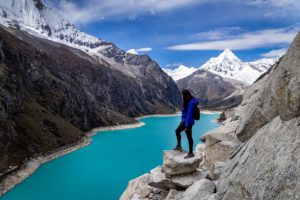Ancash ranges from a coastal strip that is not very rugged to the highest snow-capped mountains in Peru. The Chavín culture settled in this paradise between 1200 and 200 B.C., which left as a legacy the impressive archaeological complex of Chavín de Huántar, declared a World Cultural Heritage Site by UNESCO in 1985.

Photo by Andres Jacobi on istockphoto
Huascaran National Park, declared a World Natural Heritage Site by UNESCO, shelters in its beautiful scenery wildlife species such as the condor, vicuña, deer, puma, Andean fox and vizcacha.
In this emblematic place you can appreciate in all its valley the most spectacular snow-capped mountains, among them the Huascarán (6768 masl), the highest peak in Peru. Besides having hot springs and spectacular lagoons such as Llanganuco, this destination is ideal for adventure sports such as canoeing, mountaineering, mountain biking or trekking where you can enjoy the nature it possesses.

Photo by Diego Guiop on istockphoto
Countless paths to travel and magical places to discover. Do not miss the news we have for you about our trips and destinations. 😉




